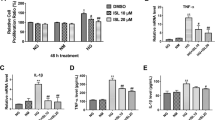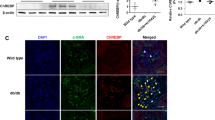Abstract
Background
We investigated the role of c-Jun NH2-terminal kinase (JNK), a member of the mitogen-activated protein kinase family, in the expression of angiotensin II (Ang II)-induced monocyte chemoattractant protein-1 (MCP-1) and transforming growth factor-1 (TGF-1), and in the production of fi bronectin (FN), by human mesangial cells (HMCs).
Methods
JNK activation in cultured human mesangial cells was determined by Western blotting with an antibody against the phosphorylated Ser63 residue of c-Jun. Binding of the activator protein (AP-1) to the MCP-1 AP-1 motif was detected via the electrophoretic mobility shift assay (EMSA). The transient luciferase reporter was used to examine MCP-1 promoter activity; an RNase protection assay and ELISA were used respectively to detect the expression of MCP-1 mRNA and production of MCP-1, TGF-β and FN.
Results
Anthra (1,9-cd) pyrazol-6(2H)-one (SP600125), a pharmacological inhibitor of JNK, almost completely abolished Ang II-induced Ser63 phosphorylation of c-Jun at concentrations of 5–20 μmol/L: JNK activity was reduced by 75% with 10 μmol/L SP600125, and by 90% with 20 μmol/L. Ang II increased AP-1 binding to the MCP-1 AP-1 motif in a time-dependent manner, as detected by EMSA, while SP600125 effectively blocked this increased AP-1 binding in a concentration-dependent manner. Treatment with 100 nmol/L Ang II led to a steady increase in MCP-1 mRNA expression, and to an enhanced production of MCP-1, TGF-β and FN. These effects were blocked by SP60025 in a dose-dependent manner. SP600125 also reduced MCP-1 mRNA stability: the halflife of MCP-1 mRNA was approximately 5 hours in cells treated with Ang II only, but was reduced to 2 hours when treated with a combination of Ang II and SP600125.
Conclusions
These results show that the JNK/AP-1 pathway is involved in the expression of MCP-1 and TGF-β, and in extracellular matrix production. JNK is an important therapeutic target for glomerulonephritis and glomerulosclerosis.
Similar content being viewed by others
References
Zhang A, Ding G, Huang S, Wu Y, Pan X, Guan X, et al. c-Jun NH2-terminal kinase mediation of angiotensin II-induced proliferation of human mesangial cells. Am J Physiol Renal Physiol 2005;288:F1118–1124.
Berrou J, Tostivint I, Verrecchia F, Berthier C, Boulanger E, Mauviel A, et al. Advanced glycation end products regulate extracellular matrix protein and protease expression by human glomerular mesangial cells. Int J Mol Med 2009;23:513–520.
Gao HX, Campbell SR, Burkly LC, Jakubowski A, Jarchum I, Banas B, et al. TNF-like weak inducer of apoptosis (TWEAK) induces inflammatory and proliferative effects in human kidney cells. Cytokine 2009;46:24–35.
Naito M, Shenoy A, Aoyama I, Koopmeiners JS, Komers R, Schnaper HW, et al. High ambient glucose augments angiotensin II-induced proinflammatory gene mRNA expression in human mesangial cells: effects of valsartan and simvastatin. Am J Nephrol 2009;30:99–111.
Mii A, Shimizu A, Masuda Y, Ishizaki M, Kawachi H, Iino Y, et al. Angiotensin II receptor blockade inhibits acute glomerular injuries with the alteration of receptor expression. Lab Invest 2009;89:164–177.
Sánchez-López E, Rodriguez-Vita J, Cartier C, Rupérez M, Esteban V, Carvajal G, et al. In Inhibitory effect of interleukin-1beta on angiotensin II-induced connective tissue growth factor and type IV collagen production in cultured mesangial cells. Am J Physiol Renal Physiol 2008;294:F149–160.
De Mello WC. Cardiac intracrine renin angiotensin system. Part of genetic reprogramming? Regul Pept 2006;133:10–12.
Grande MT, López-Novoa JM. Therapeutical relevance of MAP-kinase inhibitors in renal diseases: current knowledge and future clinical perspectives. Curr Med Chem 2008;15:2054–2070.
Kawano H, Kim S, Ohta K, Nakao T, Miyazaki H, Nakatani T, et al. Differential contribution of three mitogenactivated protein kinases to PDGF-BB-induced mesangial cell proliferation and gene expression. J Am Soc Nephrol 2003;14:584–592.
Ding G, Zhang A, Huang S, Pan X, Zhen G, Chen R, et al. ANG II induces c-Jun NH2-terminal kinase activation and proliferation of human mesangial cells via redox-sensitive transactivation of the EGFR. Am J Physiol Renal Physiol 2007;293:F1889–1897.
De Borst MH, Prakash J, Melenhorst WB, van den Heuvel MC, Kok RJ, Navis G, et al. Glomerular and tubular induction of the transcription factor c-Jun in human renal disease. J Pathol 2007;213:219–228.
Zhan Y, Kim S, Izumi Y, Izumiya Y, Nakao T, Miyazaki H, et al. Role of JNK, p38, and ERK in platelet-derived growth factor-induced vascular proliferation, migration, and gene expression. Arterioscler Thromb Vasc Biol 2003;23:795–801.
Bennett BL, Sasaki DT, Murray BW, O’Leary EC, Sakata ST, Xu W, et al. SP600125, an anthrapyrazolone inhibitor of Jun N-terminal kinase. Proc Natl Acad Sci U S A 2001;98:13681–13686.
Jin HO, Seo SK, Woo SH, Kim ES, Lee HC, Yoo DH, et al. SP600125 negatively regulates the mammalian target of rapamycin via ATF4-induced Redd1 expression. FEBS Lett 2009;583:123–127.
Naito T, Masaki T, Nikolic-Paterson DJ, Tanji C, Yorioka N, Kohno N. Angiotensin II induces thrombospondin-1 production in human mesangial cells via p38 MAPK and JNK: a mechanism for activation of latent TGF-beta1. Am J Physiol Renal Physiol 2004;286:F278–287.
Momoi A, Murao K, Imachi H, Ishida T, Cao WM, Sato M, et al. Inhibition of monocyte chemoattractant protein-1 expression in cytokine-treated human lung epithelial cells by thiazolidinedione. Chest 2001;120:1293–1300.
Nakayama K, Furusu A, Xu Q, Konta T, Kitamura M. Unexpected transcriptional induction of monocyte chemoattractant protein 1 by proteasome inhibition: involvement of the c-Jun N-terminal kinase-activator protein 1 pathway. J Immunol 2001;167:1145–1150.
Park J, Ryu DR, Li JJ, Jung DS, Kwak SJ, Lee SH, et al. MCP-1/CCR2 system is involved in high glucose-induced fibronectin and type IV collagen expression in cultured mesangial cells. Am J Physiol Renal Physiol 2008;295:F749–757.
Giunti S, Tesch GH, Pinach S, Burt DJ, Cooper ME, Cavallo-Perin P, et al. Monocyte chemoattractant protein-1 has prosclerotic effects both in a mouse model of experimental diabetes and in vitro in human mesangial cells. Diabetologia 2008;51:198–207.
Lee MJ, Yang CW, Jin DC, Chang YS, Bang BK, Kim YS. Bone morphogenetic protein-7 inhibits constitutive and interleukin-1 beta-induced monocyte chemoattractant protein-1 expression in human mesangial cells: role for JNK/AP-1 pathway. J Immunol 2003;170:2557–2563.
Lahti A, Jalonen U, Kankaanranta H, Moilanen E. c-Jun NH2-terminal kinase inhibitor anthra(1,9-cd)pyrazol-6(2H)-one reduces inducible nitric-oxide synthase expression by destabilizing mRNA in activated macrophages. Mol Pharmacol 2003;64:308–315.
Nieminen R, Lahti A, Jalonen U, Kankaanranta H, Moilanen E. JNK inhibitor SP600125 reduces COX-2 expression by attenuating mRNA in activated murine J774 macrophages. Int Immunopharmacol 2006;6:987–996.
Wu D, Peng F, Zhang B, Ingram AJ, Kelly DJ, Gilbert RE, et al. PKC-beta1 mediates glucose-induced Akt activation and TGF-beta1 upregulation in mesangial cells. J Am Soc Nephrol 2009;20:554–566.
Shi Y, Zhang Y, Wang C, Du C, Zhao S, Qi Z, et al. Suppressor of cytokine signaling-1 reduces high glucose-induced TG-Fbeta1 and fibronectin synthesis in human mesangial cells. FEBS Lett 2008;582:3484–3488.
Ziyadeh FN. Different roles for TGF-beta and VEGF in the pathogenesis of the cardinal features of diabetic nephropathy. Diabetes Res Clin Pract 2008;82 Suppl 1:S38–41.
Cheng HC, Ho TC, Chen SL, Lai HY, Hong KF, Tsao YP. Troglitazone suppresses transforming growth factor betamediated fi brogenesis in retinal pigment epithelial cells. Mol Vis 2008;14:95–104.
Author information
Authors and Affiliations
Corresponding author
Rights and permissions
About this article
Cite this article
Ding, GX., Zhang, AH., Huang, SM. et al. SP600125, an inhibitor of c-Jun NH2-terminal kinase, blocks expression of angiotensin II-induced monocyte chemoattractant protein-1 in human mesangial cells. World J Pediatr 6, 169–176 (2010). https://doi.org/10.1007/s12519-010-0033-2
Received:
Accepted:
Published:
Issue Date:
DOI: https://doi.org/10.1007/s12519-010-0033-2




